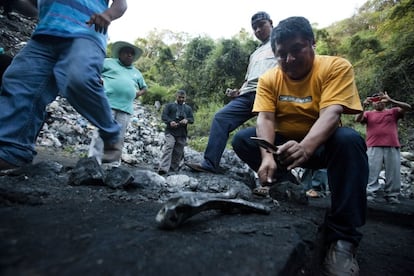Community leader who searched for missing Iguala students shot dead
Miguel Ángel Jiménez dug up dozens of mass graves in Mexico’s violent Guerrero state


Using his bare hands, Miguel Ángel Jiménez would dig into mass grave sites looking for the remains of the 43 teaching students who were kidnapped in the Guerrero city of Iguala last September and later murdered in a notorious incident that still has Mexico looking for answers.
Just the thought that these young people were taken in the middle of the night and shot in the head by unknown gunmen made Jiménez’s skin crawl, he once explained.
The thought that these young men were taken in the night and shot would make Jiménez’s skin crawl
On Saturday, the community leader, who was well-known throughout the region, himself became a victim of the cruelty he loathed and that made Guerrero infamous as one of Mexico’s most dangerous states.
Jiménez was shot dead as he was driving his taxi near his birth town of Xaltianguis, about 50 kilometers from the Pacific resort of Acapulco.
He was the leader of the so-called Union of People and Organizations of Guerrero State (UPOEG), a vigilante group whose members hold licenses to carry weapons to enforce security in towns and rural areas where police and law enforcement are absent.
For nearly two years, Guerrero has been under siege by an internal war between vigilante groups and drug traffickers, who have moved in to control the sprawling marijuana and opium fields found across the region.
Police and judicial investigators arrived at the scene to find Jiménez slumped inside his taxi. His family took his body for burial.
According to the Mexico City daily Reforma, Jiménez had received death threats after his self-defense force split into two factions. He had accused the spinoff group, led by Plácido Macedo, of being on the drug traffickers’ payroll.
Just days after the disappearance of the 43 students, Jiménez had set up tents in the center of Iguala, where volunteers – many wearing sombreros and sandals and carrying machetes – were organized to search for the youngsters who went missing on the night of September 26, 2014.
The students had traveled from nearby Ayotzinapa, and took part in a protest against the wife of Iguala’s mayor, who had planned on running for his seat.
According to the federal government’s official version, the city’s corrupt police department arrested the 43 and then turned them over to hit men who were working for drug traffickers.
More than 100 people were arrested in connection with the disappearance, including the mayor of Iguala and his wife, who have both been accused of working with local traffickers.
One suspect, who is cooperating with prosecutors, claimed that the men’s bodies were taken to a nearby trash dump and burned on a bonfire. The ashes and remains were later dumped into a river.
According to daily Reforma, Jiménez had received death threats after his self-defense force split in two
International forensic experts searching the river were only able to positively identify one of the victims because DNA belonging to the others had been destroyed by the intense heat of the flames.
But the families of the missing students do not believe the official version of events. Some claim that their loved ones were murdered by the Mexican military, but the government has denied this allegation.
Jiménez and his group never gave up looking for the bodies. During their searches, they discovered mounds filled with the unidentified bodies of those who had been executed.
EL PAÍS had accompanied Jiménez on one of those expeditions.
“They would force them to dig their own graves,” he said. “Just imagine you being here in the middle of the night, knowing that you are going to be buried here. I get goose bumps just thinking about it.”
English version by Martin Delfín
Tu suscripción se está usando en otro dispositivo
¿Quieres añadir otro usuario a tu suscripción?
Si continúas leyendo en este dispositivo, no se podrá leer en el otro.
FlechaTu suscripción se está usando en otro dispositivo y solo puedes acceder a EL PAÍS desde un dispositivo a la vez.
Si quieres compartir tu cuenta, cambia tu suscripción a la modalidad Premium, así podrás añadir otro usuario. Cada uno accederá con su propia cuenta de email, lo que os permitirá personalizar vuestra experiencia en EL PAÍS.
¿Tienes una suscripción de empresa? Accede aquí para contratar más cuentas.
En el caso de no saber quién está usando tu cuenta, te recomendamos cambiar tu contraseña aquí.
Si decides continuar compartiendo tu cuenta, este mensaje se mostrará en tu dispositivo y en el de la otra persona que está usando tu cuenta de forma indefinida, afectando a tu experiencia de lectura. Puedes consultar aquí los términos y condiciones de la suscripción digital.








































